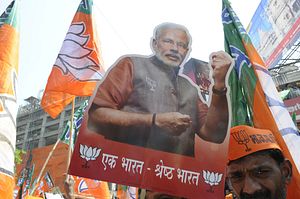Indian Prime Minister Narendra Modi’s first term in office will enter its third year in May 2016. At the beginning of the new year, it is an appropriate occasion to measure his performance so far and chart what the next year may hold for India.
Last year brought electoral setbacks for Modi’s ruling Bharatiya Janata Party (BJP) in two important states. It lost Delhi in February and Bihar in October, denting Modi’s reputation. Not long ago, the prime minister led the BJP to a historic win in the general elections in May 2014. Last year’s losses have not only shattered Modi’s aura of invincibility, but have also emboldened the opposition Congress Party, which has been struggling since its resounding defeat in the 2014 national elections.
Can the recent regional electoral setbacks put a hold on the ideas that Modi represents? Despite the dwindling popularity of the BJP’s leader, the Hindu right-wing majoritarian agenda has come to dominate popular discourse in India. For the first time in post-independence India, Hindu right-wing ideas have come to invariably dominate the national political discourse.
Last year saw the consolidation of that idea and its aggressive propagation by the BJP government. The beef debate and the ban on the meat are clear examples of how the Hindu way of life is being promoted by the ruling establishment. The promotion of yoga nationally and internationally is another example how the regime is favoring one aspect of India’s cosmopolitan and syncretic heritage over others.
The rewriting of history textbooks also demonstrates how strongly the BJP government is moving towards implementing its cultural agenda. By altering history books, the government wants to be the sole spokesperson for Hindus and promote a majoritarian history, discarding the long legacy of Muslim influence and presence in the country. By polarizing history, the BJP is trying to prove that India is predominantly a Hindu state, discarding other India’s many other cultures and ways of life.
When the first BJP government ruled the country between 1998 to 2004, it also tried to promote the Hindu nationalist agenda, but did so cautiously. This has changed with Modi’s leadership, and there is an aggressive push for this agenda today. Today, the prime minister’s supporters brand those who oppose the right wing project as an agent of the opposition or anti-Indian. This happened when India was debating rising intolerance on the part of right wing forces. Modi has not uttered a single word on the issue, which kept the whole nation agitated for months. However, his cabinet colleagues and other Hindu right-wing leaders have continued to stoke the fires of intolerance. The BJP leadership never condemned the killing of rationalists and it never expressed sorrow after the lynching of a Muslim man who was suspected of storing beef at his house. Recently, it has failed to respond when prominent writers and historians returned their awards in protest over the increasing national climate for intolerance.
This clearly demonstrates that Modi wants to advance his idea of India as the predominant narrative throughout the country at the expense of one which respects multiculturalism and promotes secularism.
If 2015 is any indication, the new year is not going to be different. The year ahead will see a renewed effort from right-wing forces to consolidate their hold on India’s Hindu majority. The signs are visible. Fringe Hindu groups have started mobilizing resources to build a temple at a disputed site in Ayodhya in eastern India. The campaign is a well-orchestrated strategy to inflame passions before the regional elections in Uttar Pradesh in early 2017. In the 1980s and 1990s, the BJP gained much popular support by campaigning aggressively on the temple issue. It abandoned the topic when it came to power for the first time because it was leading a coalition government. The BJP now enjoys an absolute majority nationally in the Lok Sabha, the lower house of parliament, and is not constrained by such political compulsion.
The prime minister meanwhile keeps on talking about development and economic well-being, but the party he heads talks in disparate voices and dabbles into sectarian politics. The ruling leadership remains silent on many contentious issues. This has become a standard political strategy. If 2015 is any indication, this is going to be the game plan in the new year also.
On the surface, India appeared politically stable in 2015. In reality, it has suffered some disturbing social conflicts, borne of a clash of ideas between the Hindu right and those who would see the nation remain pluralistic. This contest will continue and is going to be bitter in 2016. The Hindu majoritarian group sees Modi as their best chance to push their agenda and implant a new narrative for the nation.
Only time will tell how far they will succeed. One thing is certain: The year ahead will see a bitter struggle for the soul of India.

































